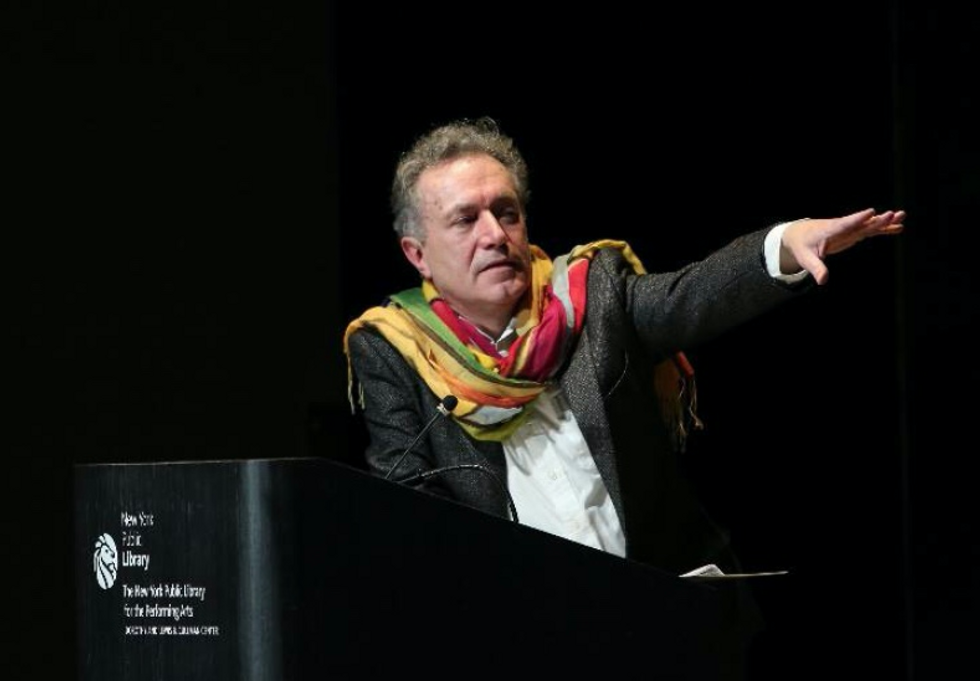Alastair Macaulay Says Goodbye: What It's Been Like as the Controversial Chief Dance Critic
During his tenure at The New York Times, Alastair Macaulay has not been accused of being timid. Or boring. As the newspaper’s chief dance critic, he has probably been the most talked-about writer in the dance world. His raves and his pans have become their own news; his words have led to as much chatter backstage as on social media.
At the end of this year, he’s passing the baton along to a new critic. (His replacement hasn’t yet been announced.) Although he’ll still contribute to the Times’ dance section through 2019, he says he wants to spend more time in his native UK, and work on a wider variety of projects, including several books.
Before he departs from his post, we took the opportunity to ask him a few of our most burning questions, and he agreed to respond over email.
What have you learned from watching the New York dance scene over the past 11 years?
To keep opening my mind to new possibilities. I grew up in a rural, conservative background. Much of my whole adult life has been a process of moving away from timidity and reactionaryism. I hope I was never racist, but I’m sure that I’ve had to go on learning to be more sensitive to racial matters. I’m sure that, when I began as a dance critic in 1978, I was in some ways horridly homophobic; it took decades to shed all that, both in my private life and in my views of the performing arts. I’ve been impressed by feminism for decades, but there are always aspects of sexism that I’ve had to rethink.
I’ve also learned how much good (often marvelous) dance there is—especially in the USA, especially in New York. When I took this job, I thought there would be much less dance to like than has proved the case. I’d never heard of Pam Tanowitz when I moved here in 2007; Justin Peck hadn’t begun to choreograph. Those are two of the first choreographers who wrote to thank me this September when my retirement was announced; I was very moved.
Looking back, are there any artists whom you wish you’d started following earlier, or feel like you missed entirely?
I began as a critic in London in 1978; I remember a ballet fan saying to me in ’79, “I’m really sorry for you, because you’ve missed the great days.” And she was right.
But, to my happy surprise, there have been other great days since then. If you’ll forgive some lists, I realize I’ve reviewed world premieres by (to start with artists now dead) Frederick Ashton, George Balanchine, Trisha Brown, Merce Cunningham, Martha Graham, Jerome Robbins and Paul Taylor as well as (to name some of the living) Richard Alston, David Gordon, Mark Morris, Justin Peck, Alexei Ratmansky, Pam Tanowitz, Twyla Tharp, Christopher Wheeldon. That’s an awful lot of the history of Western theatrical dance—and I’m only mentioning world premieres by the more famous artists.
There’s always more I’d like to have seen, but I resign myself to that. If anything, I’ve seen too much rather than too little, don’t you think?
What do you think are the biggest misconceptions about the job of a dance critic?
1. People don’t realize that critics get nervous, especially before world premieres. In London, I had to file reviews of world premieres within an hour or two of the curtain’s fall. Your adrenaline gets very high: You feel like a greyhound.
With The New York Times job, only once or twice have I had to file a review before 9 am the next day. Nonetheless the exposure is extreme. And everyone gets much more heated about what the Times critic says, even if he or she is relatively moderate.
2. It’s often assumed that critics mix with the artists they write about. I chose to do the opposite. I never once met Peter Martins. I wrote a big 1,500-word essay raving about Sara Mearns in 2014; I’ve never met her.
3. One misconception is that (to quote an old book called “The Bluffer’s Guide to Ballet”) “critics hunt in packs.”
Some critics really do love to discuss what they’ve just seen. It has its rewards; you learn from critics with keener eyes and longer memories and better formed opinions. But—even though many critics deny this—there’s actually a lot of subtle (or unsubtle) bullying going on, as well as sheer cribbing. I’ve known critics who try to tell me how to think; I’ve known critics who, having heard my opinions, then put them into print before I could publish them myself.
But the London theater critics—whose ranks I first joined in 1990—have a wonderful etiquette that you never talk about a show until all parties in the conversation have filed their reviews. I’ve tried to maintain that etiquette fastidiously. (One older New York dance critic cannot forgive me for it.)
4. People assume that my word fills houses or empties them: It doesn’t. I’ve written rave reviews that have not had the effect of filling New York Live Arts or The Joyce, let alone the big theaters. And I’m happy to say that several artistic directors have paid no attention to what I’ve said in print: I admire that, because that means they’ve got a vision of their own.
What do you see as the critic’s role in the dance ecosystem?
To reconcile heart and head; to show how emotion and intelligence can combine when absorbing works of art. To report on and to evoke an event for those who weren’t there. To provoke and enrich discussion of dance. To help people show how many elements—how many values—go into the process of judgment.
How does it feel when people get quite heated over your reviews? Has anyone ever confronted you?
I grew up in a climate when the most striking critics were deliberate controversialists. Clement Crisp began a 1980 Financial Times review with the words, “Béjart and Stravinsky is one of those fabled partnerships, like Romeo and Goneril, or bacon and strawberries.” Arlene Croce began a 1970s New Yorker review with the words, “On a grim night in Stockholm, you can either throw yourself in a canal or go to the Royal Swedish Ballet.” Those two writers were great influences on me and remain beloved friends of mine. I’ve dropped a number of bombs in my time. The Financial Times had to consult its lawyers about what I wrote about Andrew Lloyd Webber, two of whose world premieres I reviewed. (The lawyer allowed my prose to pass unchanged.)
For better or worse, the 2010s are milder days, and—whether people are aware of it or not—I’ve grown milder too. Yes, some dancers and choreographers have complained to me, but fewer than have thanked me.
One male principal dancer texted me this year, very confrontationally, to complain about a piece by me that he hadn’t even bothered to read in its original—he’d merely seen a quotation from it about himself on social media. I’ve known some critics be very vindictive: They’d have persecuted him in print ever afterward. As it happened, I replied very mollifyingly—but he wasn’t to know that I wouldn’t savage him in my next review.
Some choreographers have been scared of me. At least two suddenly announced that their premieres were not for review once they heard I was planning to come. (One of them changed her mind again when, at short notice, I was unable to attend!) But I certainly don’t mean to scare anybody, and I don’t dwell on any reasons they might be alarmed by the idea of my review.
On the whole, though, I don’t hear from those I review—and that’s how it should be. One modern dancer wrote to thank me for what I’d written: I wrote back advising him not to thank critics, since who knows? We may change our minds.
 Delivering the Lincoln Kirstein Lecture for the Center of Ballet and the Arts, “Ashton and Balanchine: Parallel Lives.” Photo by Gilbert Gaytan, courtesy Macaulay
Delivering the Lincoln Kirstein Lecture for the Center of Ballet and the Arts, “Ashton and Balanchine: Parallel Lives.” Photo by Gilbert Gaytan, courtesy Macaulay
Did you ever write something that you later regretted or reconsidered?
As a therapist once assured me in the 1990s, I’m not complacent. I regret commas, adjectives, clumsy turns of phrase, even if nobody else is bothered by them. Worse, I’m dismayed by the factual inaccuracies I’ve committed.
Opinions I regret less. So what if you hated the world premiere of The Rite of Spring or Waiting for Godot? Those are tough pieces that are easy to misunderstand even now. When I was younger, I seldom changed my views; now I’m older, I’ve been modifying my position more often. Good: That’s progress.
The biggest controversy of my career was my “one sugar plum too many” review in 2010, about Jenifer Ringer in The Nutcracker. In 1892, the original Sugar Plum Fairy was called “podgy” and “corpulent” by a Russian critic; before 2010, other Western critics discussed dancers being overweight. I happened to choose the expression I did because others that night were struck by the dancers’ weight more than I was. (“God, they’re fat!” someone near me audibly exclaimed after the pas de deux.) I used the phrase “one sugar plum” because, unlike them, I thought Ringer was only a smidgeon too plump. How big’s a single sugar plum?
Nonetheless the brouhaha went global and viral. For several weeks, it was frightening.
In the long run, however, I’m glad that that furor happened. It was no fun to be at the epicenter. But it taught everyone—and not just me—not to talk that way about women’s (or men’s) bodies any more. Onward and upward.
One regret alone has gnawed at me—my decision to leave my old job as a London theater critic. I love dance. But every critic has areas where their antennae take in more information. For some other critics, that’s dancing. I realized, too late, that my own antennae are especially sensitive about the human voice, speaking or singing, and that I’d become known as the London theater critic most responsive to vocal matters. Also I’d become known as a particularly acute critic of acting. I’ve missed that, immensely (and anyway I’m homesick for London and the UK). Voice apart, I adored the wealth of new plays, the amount of comedy (dance critics seldom get to laugh out loud in the theater), the exciting number of political plays that gave me new information about the world, the cornucopia of classic plays that are always being rediscovered, and all that exposure to the endless marvels of Shakespeare. And I can never believe I gave that up.
Yet I took this job for a good reason: I wanted new adventures, to step out of my comfort zone. I was 51; I knew the fifties are a classic time for a midlife crisis, which always begins with the question “Is this all?” Well, here was The New York Times inviting me to change my life. Dance is singularly hard to write about, and I’ve kept trying to go for the things I find hardest of all or just the things about which I knew least. And if you want to know the hardest thing in criticism, I’ll tell you: choreographic musicality. Thousands of us know how very differently Balanchine and Taylor respond to the same music in Concerto Barocco and Esplanade; almost nobody has discussed that difference. But I’ve loved trying.
Your first major project post-retirement will be finishing your Merce Cunningham book. But you also have 22 other book ideas! Which are you most excited about?
I’ve certainly done plenty of the spadework for books on The Nutcracker, on “Ashton and Balanchine: Parallel Lives,” on Balanchine’s Serenade, and on the depictions of dance in Degas‘ paintings and sculpture. So I’m impatient for those.
The Princeton musicologist Simon Morrison and I have been talking about a new Tchaikovsky’s Ballets book. I’ve spent over 30 years researching and thinking about Adolphe Nourrit, the great Romantic tenor who wrote the original scenario for La Sylphide and thus conceived the first Romantic ballet. I long to write at greater length about Harold Pinter, especially his depictions of women and his much-underrated quality of compassion. I wrote two long essays on dance classicism in 1987 and 1997; I’ve got much more to say on the subject now. There’s a book to be written on the singers, actors and dancers who have most redefined for me the potential of theatrical performance. Shakespearean verse-speaking—all Shakespearean acting—is an obsession of mine; I was being approached to write a book on that when this job came along. Another fascination is the device of the play-within-the-play: the way A Midsummer Night’s Dream contains the Pyramus-and-Thisbe play, the way Fred and Ginger are often putting on shows within their film, the way Stoppard’s plays and David Gordon’s pieces contain other plays.
I’m aware some will change as they ferment in my mind. And I’ll never have time for them all anyway! Frankly, after 40 years in criticism, I’m looking forward to staying home more often, spending more time with family and friends, and sitting still to read books and listen to music.
 As one of the speakers for the unveiling of the plaque commemorating Merce Cunningham at Westbeth in New York City on September 20, 2018. Courtesy Macaulay.
As one of the speakers for the unveiling of the plaque commemorating Merce Cunningham at Westbeth in New York City on September 20, 2018. Courtesy Macaulay.
More than maybe any other critic, you often comment on same-sex partnering (or lack thereof) in your reviews. Why has that been a particular focus for you?
Since my retirement has been announced, I’ve been told I’ve commented on quite a number of things more than any other critic! Those include the importance of eyes, the value of footwork, the diversity of musicality. A press officer just told me she’ll miss most the way (outside the Times) I always refer to the “D*v*d H. K*ch Theater”! I myself would say the three things I’ve given new prominence to are the dimensions of Merce Cunningham dance theater, the complexity of choreographic musicality and the depth and breadth of Indian dance.
This is the first time anyone has said I’ve especially remarked on same-sex partnering, but that’s okay. I hope it’s true. It’s part of a larger social agenda in my work: I’ve also spoken of the importance of women supporting men. The reason is obvious: These things are happening in the wider world outside dance! Same-sex marriage has become a major topic across the West, and most of us know opposite-sex marriages where the woman has supported the man. Why should dance exclude these things?
What will you miss about the job?
The readers! It’s been amazing to hear from experts on Balanchine and Cunningham, on the Indian genres of Odissi and Kathak and Bharatanatyam, on tango, on flamenco. I’m not a dancer; I’m an outsider, an amateur, a wallflower. How astonishing to find my reviews have worked for them; some of them have even written that I’ve helped them to understand their own genres better. One Madrid critic kept writing to me to thank me for maintaining flamenco standards when (she felt) nobody over there was.
But I’ve also heard from many other wallflowers—people who don’t dance or even go to see dance. (I remember in London the critic of the Evening Standard said that he wrote for the reader who only read the dance review because he’d read everything else in the paper and he had nothing else to read because he was on a London Underground train that was stuck between stations. I loved that idea.)
I’ll also miss the travel, the constant supply of new friends, and the intense drama (and terror) of being among the very first to report on big first nights.
If you were forced to watch just one dance work over and over again for the rest of your life, what would you choose?
Cunningham’s Doubles (1984), a poetic and amazingly layered piece, full of contrasts, that he was working on reconstructing in the closing months of his life. Cunningham’s work abounds in doubleness, ambiguity, layers. He always planned Doubles with alternate casts, whom he encouraged to accentuate its solos in ways quite unlike one another. Humanity, time and space, all take off, lyrically, intimately. There’s always something new there.





